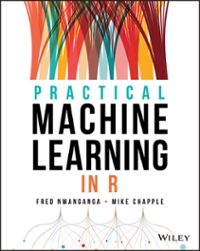3. After developing the model in exercise 2, you obtained additional information about the individuals in the
Question:
3. After developing the model in exercise 2, you obtained additional information about the individuals in the study. Specifically, you learned how many prior times each person participated in the screening program. You incorporate that information into your model and obtain these results:
Call:
glm(formula = participated ˜ age + maritalStatus + ethnicity +
priorScreenings, family = binomial, data = patients_train)
Deviance Residuals:
Min 1Q Median 3Q Max -2.1965 -0.6845 0.2264 0.5264 2.1374 Coefficients:
Estimate Std. Error z value Pr(>|z|)
(Intercept) 0.420756 0.692364 0.608 0.5434 age -0.017940 0.002855 -6.284 3.31e-10 ***
maritalStatusMarried 0.078128 0.225397 0.347 0.7289 maritalStatusNot Known 0.205479 0.241209 0.852 0.3943 maritalStatusSingle -0.352247 0.236139 -1.492 0.1358 maritalStatusWidowed -0.035840 0.406231 -0.088 0.9297 ethnicityAsian -1.095094 0.653537 -1.676 0.0938 .
ethnicityBlack or African American -1.151009 0.654967 -1.757 0.0789 .
ethnicityHispanic -0.953887 0.656464 -1.453 0.1462 ethnicityNative Hawaiian or Other Pacific Islander -11.293698 196.968754 -0.057 0.9543 ethnicityTwo or More -1.341665 0.679203 -1.975 0.0482 *
ethnicityUnknown -1.093776 0.666182 -1.642 0.1006 ethnicityWhite -1.076935 0.644631 -1.671 0.0948 .
priorScreenings 1.619062 0.040467 40.010 < 2e-16 ***
---
Signif. codes: 0 ‘***’ 0.001 ‘**’ 0.01 ‘*’ 0.05 ‘.’ 0.1 ‘ ’ 1 (Dispersion parameter for binomial family taken to be 1)
Null deviance: 8464.2 on 6111 degrees of freedom Residual deviance: 5267.5 on 6098 degrees of freedom AIC: 5295.5 Number of Fisher Scoring iterations: 10
a. Are individuals who participated in a past screening more likely to participate in future screenings, less likely to participate in future screenings, or is it not possible to determine a difference?
b. For each time an individual participated in a past screening, by what factor do the odds change that they will participate in the next screening?
c. Which model fits the data better, the model from exercise 2 or this model? How can you tell?
Step by Step Answer:

Practical Machine Learning In R
ISBN: 9781119591535
1st Edition
Authors: Fred Nwanganga, Mike Chapple






